I wondered why it was so quiet, since I knew I was going to an outdoor performance. Sure enough, once I thought that, I started to hear some music in the distance and knew I was going in the right direction. This space was built right at the shore though it's a little weird because the water doesn't go back and forth between the sea and the stage area. It also blocks the view of where the rocks meet the water. But it was still a welcome and stunning sight.
Brenda's husband Jan (left) was performing with Kijene (right) and I caught only the very end of the first set, which was actually better timing than I had feared. I was so glad that I had reached my final destination for the day and could finally relax.
The site had these comfortable cushions (the aqua blue ones) to sit and watch, and you can see Brenda standing at the right of the three standing folks, with Kang Mi-kyoung in the center wearing the hat. She was the instigator for all the dancing, and as soon as Brenda introduced me to her, she took me immediately to the actual water. [of course, this was after I said hi to Yang Soon-ja, who had come from a family wedding that I couldn't attend because of the gat appointment. She was on her way home after the first set but left me with a cold beverage, always taking care of what I eat!]
Walking past the stage area we got to the rocks and the water, which was so refreshing. After we had walked out, the tides had started coming in a bit so I had taken off my shoes, and then she asked if I wanted to sit and dunk my feet for a bit, which I DID. [She was born on one of those islands out in the distance, which we could see from almost every place we were that evening.]
If not for all the people and all my stuff, I would have stripped down to go in completely, which makes sense as this was where she said she grew up as a child, playing with the fish and hanging out at sea. Her mother was a haenyeo, though she had to stop working after her eardrum burst from going a bit too deep one day at work.
The water was so clear that you could see right to the rocks as we walked. This was Mi-Kyoung's playground.
Though I wanted to linger, we had to get back for the second set, where of course she insisted we dance to improve the ambiance of the place, which was not so much focused on the music but shopping and hanging out at the various booths. She got us some lovely snacks from one of them while Brenda talked with the team for the Keurida Project, a documentary about an adoptee returning to Seoul for the first time since she was adopted. Brenda is in the scarf talking to Cleo in the hat, the subject and co-director, while Crystal, another co-director, is trying to film in lighting that is really hard to deal with. Somehow after Jan's set was over, we managed to herd everyone over eventually to a nearby restaurant for dinner and more conversation.
There is a haenyeo school here and two restaurants side by side. I believe one is run by haenyeo and the other by haenyeo students, of course using their catch from the sea. We each had a bowl of noodles and then shared haemul pajeon (seafood pancake).
Mi-kyoung of course insisted on treating the entire group, which included crew and musicians. She even led us all in a guided meditation on the rocks before we said our farewells at the end of the evening, as that is her big goal: to teach more people about traditional Korean meditation. While we were soaking our feet, she talked about how the deeper and more subtle Korean traditions are being lost and mostly unknown, like this meditation, and how she hopes to share it with more people around the world someday.
After dinner, the team wanted to shoot a conversation between Mi-Kyoung (who herself is an amateur haenyeo) and Cleo. There was a woman who I thought was the interpreter (but turned out to be a producer), and she insisted that I interpret. I resisted at first, saying that she should go ahead, but then she said, "It's better for a local to do it." I was astounded that they thought I was a local in any way (please note that everything I was wearing were the last remnants of clean clothes I had, which included pants that I sewed at home for indoor wear only, as I was staying in Jeju longer than I had initially planned). But I roll with a lot here, maybe too much, and started the work.
Fortunately, Mi-Kyoung was using some English words (that are only intelligible as English to Korean folks) and I had read about haenyeo, so I wasn't completely in the woods. Plus, one of their crew members would jump in if I couldn't find a word in the dictionary app fast enough. At a certain point, I also just fudged what I could because 1. I'm not a professional interpreter and 2. I was getting really tired. I thought so much of the natural dye symposium panel I was part of earlier this month, and our intrepid interpreter. It wasn't okay at first but I noticed near the end that my energy was really flagging because I was concentrating so hard on listening, remembering, and then interpreting. Seriously, how do the professionals do it?!
One last snap before we got to Jan's car for the drive home. I was so grateful for the whole experience, as it made me realize how much better my language skills have gotten. Even at the gat hall, Ms. Yang kept saying how nice it was that I spoke Korean, as her own sister's children have lost theirs living in Ohio. She said, "I can't talk to them." This made me sad. But I was glad that she felt comfortable meeting me, as she had admitted when I had called her the day prior warning her that I was Korean American, that she thought I wouldn't be able to speak the language.
The next morning, I made another beach visit as it seemed to be the best way to start each morning, and then went to see Yang Soon-ja again at Mongsengee for the last time, to pick up my dyed hanji. She insisted that we drench it and hang it on the line at her house while we had a mid-morning snack...before she took me to church! She very generously defrosted the sora (conch) that she had bought the prior day, which are a big part of the haenyeo catch. Even in pandemic, people are going to church. It's kind of a miracle that I made it almost four months and hadn't been dragged to church yet. It was nicer than other experiences because it was a small country church in a very sweet little building with a lovely garden. The pastor seemed to have missed his calling because I think he would have liked to be a pop star with all of the loud, earnest singing, skinny jeans and trendy sneakers, and so on. Korean churches are where I suddenly lose my capacity to understand the language, so I was glad when the service ended.If not for all the people and all my stuff, I would have stripped down to go in completely, which makes sense as this was where she said she grew up as a child, playing with the fish and hanging out at sea. Her mother was a haenyeo, though she had to stop working after her eardrum burst from going a bit too deep one day at work.
The water was so clear that you could see right to the rocks as we walked. This was Mi-Kyoung's playground.
What a playground.
She pointed out Hallasan, the giant mountain/old volcano that is at the center of Jeju Island. It is the highest mountain in South Korea and in good weather you can see it in the distance, which helps orient you as it's right in the middle. I had forgotten the story about how Mt. Halla is in the shape of a woman laying down, seeing the profile of her face all the way down to her body. Everywhere I went, Hallasan was a great comfort.Though I wanted to linger, we had to get back for the second set, where of course she insisted we dance to improve the ambiance of the place, which was not so much focused on the music but shopping and hanging out at the various booths. She got us some lovely snacks from one of them while Brenda talked with the team for the Keurida Project, a documentary about an adoptee returning to Seoul for the first time since she was adopted. Brenda is in the scarf talking to Cleo in the hat, the subject and co-director, while Crystal, another co-director, is trying to film in lighting that is really hard to deal with. Somehow after Jan's set was over, we managed to herd everyone over eventually to a nearby restaurant for dinner and more conversation.
There is a haenyeo school here and two restaurants side by side. I believe one is run by haenyeo and the other by haenyeo students, of course using their catch from the sea. We each had a bowl of noodles and then shared haemul pajeon (seafood pancake).
Mi-kyoung of course insisted on treating the entire group, which included crew and musicians. She even led us all in a guided meditation on the rocks before we said our farewells at the end of the evening, as that is her big goal: to teach more people about traditional Korean meditation. While we were soaking our feet, she talked about how the deeper and more subtle Korean traditions are being lost and mostly unknown, like this meditation, and how she hopes to share it with more people around the world someday.
After dinner, the team wanted to shoot a conversation between Mi-Kyoung (who herself is an amateur haenyeo) and Cleo. There was a woman who I thought was the interpreter (but turned out to be a producer), and she insisted that I interpret. I resisted at first, saying that she should go ahead, but then she said, "It's better for a local to do it." I was astounded that they thought I was a local in any way (please note that everything I was wearing were the last remnants of clean clothes I had, which included pants that I sewed at home for indoor wear only, as I was staying in Jeju longer than I had initially planned). But I roll with a lot here, maybe too much, and started the work.
Fortunately, Mi-Kyoung was using some English words (that are only intelligible as English to Korean folks) and I had read about haenyeo, so I wasn't completely in the woods. Plus, one of their crew members would jump in if I couldn't find a word in the dictionary app fast enough. At a certain point, I also just fudged what I could because 1. I'm not a professional interpreter and 2. I was getting really tired. I thought so much of the natural dye symposium panel I was part of earlier this month, and our intrepid interpreter. It wasn't okay at first but I noticed near the end that my energy was really flagging because I was concentrating so hard on listening, remembering, and then interpreting. Seriously, how do the professionals do it?!
One last snap before we got to Jan's car for the drive home. I was so grateful for the whole experience, as it made me realize how much better my language skills have gotten. Even at the gat hall, Ms. Yang kept saying how nice it was that I spoke Korean, as her own sister's children have lost theirs living in Ohio. She said, "I can't talk to them." This made me sad. But I was glad that she felt comfortable meeting me, as she had admitted when I had called her the day prior warning her that I was Korean American, that she thought I wouldn't be able to speak the language.
Afterwards, we went with another member of the congregation back to Ms. Yang's home to eat lunch (kimbap provided by the church) and take my hanji off the line. Because of a sudden appointment that the other woman made for Ms. Yang, we only had time for her to drive me partway to my destination, but at this point I am so used to being dumped on the side of the road to find a bus stop that I was happy to jump out with my crunchy stash of hanji and ask Brenda if I could come directly to her house to make use of her sunny lawn. I got the paper wet at her house and we lay it out on the lawn before retiring for a nap (this is the best kind of friend to have: someone who allows you to have nap time!!).
When we got up from our respective naps, the hanji had already dried and started to take on more color, so we did one more round of dunking in water and laying out, but this time added volcanic rocks from her pathway to weigh them a bit as the afternoon wind was starting to pick up.
They mostly stayed put until we got back a few hours later!
Brenda drove us through some of the villages and eventually to one of her favorite spots in Wollyeong-ri. I had noticed campers on all of the beaches I saw, and this was no exception. Though these people looked more like they pitched tents for the day to eat and hang out, not to sleep, like at Gwakji and Hyeopjae beaches. I found this really weird but Brenda explained that it's partly a result of pandemic and people feeling so cooped up inside.
Jeju is usually a major honeymoon destination so it seemed apt to see a couple staging their wedding photos on the path.
The views were stunning, not only of the water and rocks but of the flora.
This area is known for its cactus colony. I know, how random!
We walked further out to an area that was really lovely but before I could take pictures, I saw a boat coming back into harbor and asked Brenda what kind of boat it was. She said, it's haenyeo returning from sea! So we rushed back to watch.
By the time we got there, most of the haenyeo had gotten off the boat except a couple who were helping the guy operating the crane hook their catch on to lift from the boat.
When we got up from our respective naps, the hanji had already dried and started to take on more color, so we did one more round of dunking in water and laying out, but this time added volcanic rocks from her pathway to weigh them a bit as the afternoon wind was starting to pick up.
They mostly stayed put until we got back a few hours later!
Brenda drove us through some of the villages and eventually to one of her favorite spots in Wollyeong-ri. I had noticed campers on all of the beaches I saw, and this was no exception. Though these people looked more like they pitched tents for the day to eat and hang out, not to sleep, like at Gwakji and Hyeopjae beaches. I found this really weird but Brenda explained that it's partly a result of pandemic and people feeling so cooped up inside.
Jeju is usually a major honeymoon destination so it seemed apt to see a couple staging their wedding photos on the path.
The views were stunning, not only of the water and rocks but of the flora.
This area is known for its cactus colony. I know, how random!
We walked further out to an area that was really lovely but before I could take pictures, I saw a boat coming back into harbor and asked Brenda what kind of boat it was. She said, it's haenyeo returning from sea! So we rushed back to watch.
By the time we got there, most of the haenyeo had gotten off the boat except a couple who were helping the guy operating the crane hook their catch on to lift from the boat.
We waited with everyone else, as cars had arrived simultaneously to pick up different members of this group.
The orange things are their floats, I think, while their catch is in the green nets. And they are heavy.
See the pair carrying a net together? They're coming closer towards us.
One haenyeo empties her net to sort through the sora she has harvested at sea.
Eventually after they pick out any duds, the haul will go to be weighed and sold.
This haenyeo worked on her own to empty her net. It's hard to see from the pictures, but these are NOT big women. However, they are extremely strong.
After that, I felt so fortunate to have been able to see working haenyeo in person, and we walked back through the village. Though I was jealous of the people in the water, it was more valuable to have seen the women who really know how to be in the water, as it's not as easy to experience.
The next morning, Brenda and her friend (kind of like an adopted niece) Yujin came by to pick me up with my bags for my final day. We went to Gwakji beach, my favorite, and went to the best fish & chips place.
I never do closed mouth smiles but by the time Brenda had run outside to shoot us from there, I had started to eat, so my mouth is full.
Our final adventure was Brenda's and Yujin's local ice cream store, entirely run on the honor system. What? When Brenda wrote about this in her book about Jeju, I thought it was just one self-serve machine or something. But no. It's a ton of freezers full of SO many different kinds of ice cream!
No attendant, no cashier, no one inside. You just use this machine to scan barcodes and pay.
Yujin and Brenda kept trying to figure out their options.
This board of post-its says on top, something like, "You are doing plenty well enough right now!" I'd like to believe that, and on Jeju I did.
The orange things are their floats, I think, while their catch is in the green nets. And they are heavy.
See the pair carrying a net together? They're coming closer towards us.
One haenyeo empties her net to sort through the sora she has harvested at sea.
Eventually after they pick out any duds, the haul will go to be weighed and sold.
This haenyeo worked on her own to empty her net. It's hard to see from the pictures, but these are NOT big women. However, they are extremely strong.
After that, I felt so fortunate to have been able to see working haenyeo in person, and we walked back through the village. Though I was jealous of the people in the water, it was more valuable to have seen the women who really know how to be in the water, as it's not as easy to experience.
The next morning, Brenda and her friend (kind of like an adopted niece) Yujin came by to pick me up with my bags for my final day. We went to Gwakji beach, my favorite, and went to the best fish & chips place.
The view from inside.
And from inside (obviously I didn't order fish & chips but this shrimp burger was very good and messy).I never do closed mouth smiles but by the time Brenda had run outside to shoot us from there, I had started to eat, so my mouth is full.
Our final adventure was Brenda's and Yujin's local ice cream store, entirely run on the honor system. What? When Brenda wrote about this in her book about Jeju, I thought it was just one self-serve machine or something. But no. It's a ton of freezers full of SO many different kinds of ice cream!
No attendant, no cashier, no one inside. You just use this machine to scan barcodes and pay.
Yujin and Brenda kept trying to figure out their options.
This board of post-its says on top, something like, "You are doing plenty well enough right now!" I'd like to believe that, and on Jeju I did.








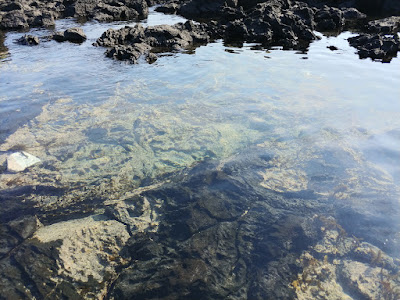









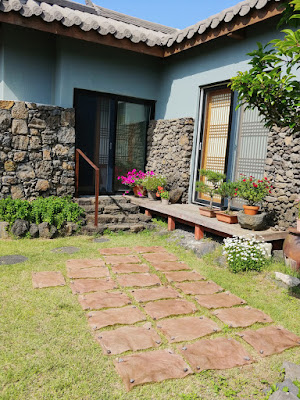


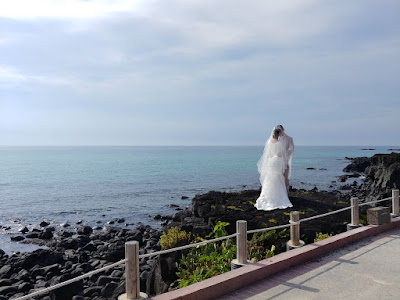









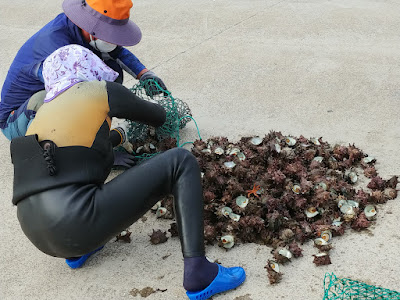











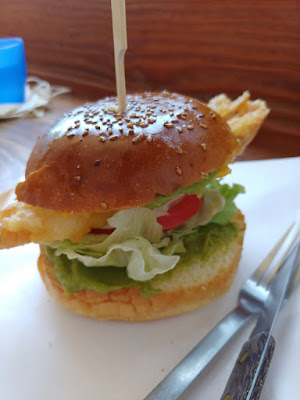





No comments:
Post a Comment